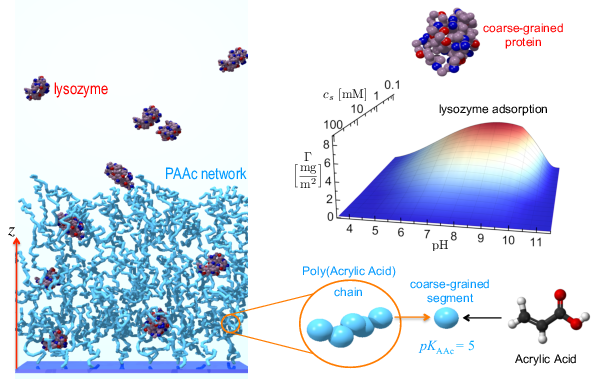Overview
The focus of our research is on the molecular modeling of soft and nanostructured materials. We develop and apply theoretical models and computer simulations. Our goal is to understand how molecular interactions and nanoscale organization interplay and determine the macroscopic behavior of these complex systems. This knowledge is essential for the rational design of experimental systems. Our projects usually involve close collaboration with experimentalists. Molecular models allow for an extensive exploration of the system parameter space, otherwise not accessible in experiments.
Stimuli-responsive hydrogels
Hydrogels of crosslinked stimuli-sensitive polymer chains are of great interest in a wide range of applications, spanning areas such as biomaterials, drug delivery, microfluidic and nanotechnology. The response of these materials can be externally triggered using the changing the chemical and/or physical properties of the environment, including temperature, pH, salt concentration, applied electric field, and concentration of biomolecules. For example, polyacid hydrogels can swell many times (up to a thousand-fold) their volume in response to small variations in the pH. These materials can be used for the controlled oral delivery of therapeutic agents, taking advantage of the changes in pH that occur in the digestive tract. To study these materials at the fundamental level we have developed a Molecular Theory, in collaboration with Prof. Szleifer and M. Olvera de la Cruz (Northwestern University). This theory combines molecular simulations with the Statistical Mechanics treatment of the system. We study how hydrogel response depends on the nanoscale coupling between environment (the stimulus), intra and inter-molecular interactions, polymer architecture and molecular organization. Understanding how to control hydrogel response to different stimuli, in terms of network molecular design and local chemical composition, can help the development of materials with extended functionality.
Protein adsorption in hydrogels
Nowadays, an increasing number of therapeutic drugs are proteins. In drug delivery, polymer hydrogels are currently considered for the encapsulation/release of proteins. Hydrogels are extensively used in chromatography for the inmobilization/purification of proteins. We study protein adsorption inside stimuli-responsive hydrogels. In particular, how do both the environment and resulting hydrogel response affect adsorption and protonation of proteins inside the material?
Nanofluidic diodes
Nanofluidic diodes are able to rectify ion transport, closely resembling voltage-gated biological ion channels. During the last decade, the very possibility of generating synthetic nanoarchitectures with functionalities comparable to biological entities has sparked the interest of the scientific community in diverse research fields. In this context, a fundamental understanding of the key features that determine the rectifying properties of the conical nanopores is essential. To study the interaction of the ions and the charges inside nanochannels, we use Monte Carlo simulations (MC) and the Poisson-Nernst-Planck formalism.
Adsorption onto nanostructurated materials
Adsorption plays a central role in the study of porous materials, providing a fundamental tool for material characterization. Many useful practical applications of porous materials are achieved through adsorption. The discovery or synthesis of new classes of porous materials is associated with the expansion and renewal of technological applications of sorption processes. In addition, the development of new types of porous sorbents has often lead to basic studies of new physical behavior in systems formed by sorbates interacting with sorbents. In the theoretical/computational study of this process, we use two main methodologies: Monte Carlo Simulations (MCS) with the Grand Canonical Ensemble and calculations using Mean – Field -Approximation (MFA) of the Lattice Gas Model.



